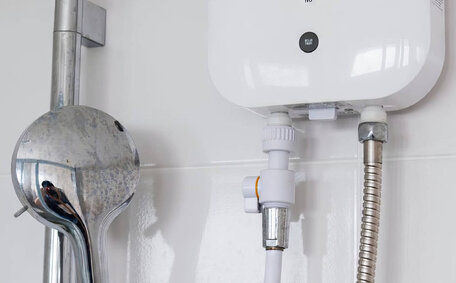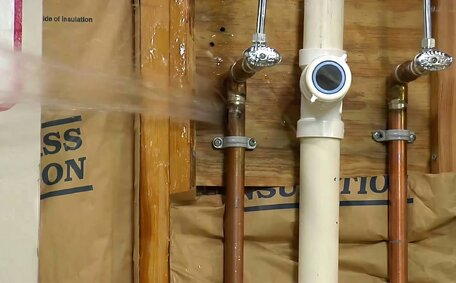Introduction to Pipe Relining
Pipe relining revolutionises the industry by enabling the repair of damaged pipes without extensive excavation, contributing significantly to market growth. It has emerged in recent years as a modern solution that can restore ageing or deteriorated pipe systems, catering to both residential and commercial properties.
The curedinplace pipe CIPP process involves inserting a resin-saturated felt lining into damaged blocked pipes and curing it in place with hot water, steam or UV light. This creates a new, fully structural and watertight pipe system with smooth inner surfaces and enhanced durability, outlasting the original pipes.
This process, known as cured in place, effectively creates a 'pipe within existing pipe structures’ by forming a new one that is seamless and integral to the damaged pipe.
Being less invasive, more efficient, and more cost-effective than traditional pipe repair methods, trenchless pipe relining stands out as a superior option. For property owners, trenchless pipe relining safeguards the plumbing system against leaks and tree root invasions, eliminating the need for disruptive excavations. This method also significantly reduces restoration costs and protects your property without the need for destructive digging, thus preventing community disruption.
As infrastructure continues to age, the demand pipe relining services, including trenchless repairs, is poised to expected grow significantly. With the anticipated market growth, the focus of ongoing developments in pipe relining solutions is on enhancing their efficiency, cost-effectiveness, and performance. Incorporating current market research, this article offers insights into the global pipe relining market, providing detailed information about key advancements shaping the future of pipe relining techniques and their industry impact.
The Evolution of Pipe Relining Technology
The pipe relining methodologies have greatly evolved to meet the increasing demand for pipe restoration, reflecting the market’s expansion. In the past, traditional methods for pipe repair entailed extensive excavation and replacement of entire pipe sections. This approach was intensely disruptive, leading to costly, and time-consuming repairs.
The advent of pipe relining in the 1970s marked a transformative milestone, reshaping the market landscape. The pipe cipp pullinplace method includes the insertion of a resin-coated felt tube into the damaged pipe, which is then cured in place with hot water or steam. The resin hardens into a smooth, jointless pipe lining.
Other key innovations that shaped the global pipe relining industry include sliplining, where new pipe lining is inserted inside the old one, and pipe bursting, which breaks up the old pipe while simultaneously pulling in the new lining. These trenchless methods create a durable pipe lining without the need to excavate existing pipes.
Today, thanks to technological advancements, sophisticated pipe relining processes employ methods that bolster the durability and effectiveness of repairs. Plumbing professionals are now applying various relining solutions such as epoxy coating, UVIR curing, and real-time monitoring to achieve stronger, longer-lasting repairs. Market players are now introducing new high-tech materials like fibre-reinforced polymer liners and advanced epoxy resins, resulting in superior corrosion resistance.
Looking ahead, global pipe relining aims to enhance the efficiency and effectiveness of servicing your pipes even further. Development areas include robotic devices for hard-to-reach pipes, remote-controlled relining, and nanotechnology for improved linings. The future looks bright for those wanting to discover more about technology that can demonstrate a free sample of how it can fix pipe problems faster and more affordably than ever before.
Key Milestones in Pipe Relining
Key milestones have significantly influenced the evolution of pipe relining technology:
- 1971 - The first patent for pipe cipp relining is issued, pioneering trenchless pipe repair.
- 1980s - UV light curing systems allow for faster, more controlled resin curing.
- 1990s - High-strength epoxy resins enhance lining durability and chemical resistance.
- Early 2000s - Robotic devices emerge enabling access to difficult-to-reach pipes.
- 2010s - Composite materials like fibre-reinforced polymers improve strength and flexibility.
- Today - Remote-controlled robotic relining reduces risks and costs.
Since its introduction, pipe relining has dramatically improved, reducing repair times from weeks to mere days or hours. Material innovations have led to linings that considerably extend your pipes’ lifetime, with an expectancy of 50 to 100 years. Ongoing advancements aim to make repairs even faster, less disruptive and more durable through new technologies like nanotech linings and remote-controlled robotics.
Emergence of Trenchless Pipe Repair Methods
Trenchless technology for pipe repair, such as CIPP relining, offers a cost-effective and less environmentally impactful solution, marking a significant advancement for the plumbing industry. Compared to traditional pipe replacement, Trenchless methods boast a more environmentally friendly profile being cost-efficient, convenient, and less damaging to the environment compared with traditional pipe repair options.
One of the most commonly used and innovative pipe relining techniques is the CIPP relining method. This involves inserting a resin-coated felt tube into the damaged pipe then curing it in place using hot water or steam. The resin, once inserted into the pipe, cures to form a tight-fitting, jointless pipe lining able to last decades.
Other key trenchless repair methods include:
- Pipe bursting - this technique involves breaking up the old, used pipe using a bursting tool while simultaneously installing a new liner.
- Sliplining - a new pipe is inserted inside the damaged one like a sleeve.
- Grout-in-place - voids around the pipe are filled by pressure injecting grout.
- Epoxy coating - an epoxy resin is sprayed on and cured to seal leaks.
Here in Bexley, Sydney, relining local sewer pipes has utilised CIPP and epoxy coating techniques for effective restoration. Opting for the non-invasive solution we needed, relining saved us over 50% in costs and bypassed weeks of disruption. Park visitors and wildlife were unaffected.
Pipe relining services offer considerable cost savings and ensure enhanced structural integrity, longevity, and environmental conservation compared to traditional replacement. As materials and equipment continue improving, trenchless techniques offering relining services are poised to become the number one pipe restoration method going forward.
Advent of Advanced Resin Materials
The development of advanced composite resin materials represents a major innovation in the pipe relining industry. Traditional pipe relining uses thermoset resin systems like polyester or vinyl ester. While effective, these have limitations in chemical resistance and long-term durability.
In the 1990s, epoxy resins emerged as a stronger and more versatile material for pipe relining. Epoxies provide excellent adhesion, chemical resistance, and corrosion protection. However, traditional epoxies can be brittle.
In the 2000s, fibre-reinforced polymer (FRP) liners combined the strength of epoxy with the durability of glass or carbon fibre. This improves flexibility and impact resistance. Other advanced composites, such as Nu Flow technologies, use nanoparticles to enhance epoxy at a molecular level.
Advanced composite relining extends the lifespan of potable water pipes to 50-100 years. North America has seen notable successes, such as an epoxy-fibre lining installed in 2012 at a New York water treatment plant, achieving a design life of 100 years. The high initial material costs are offset by long service life and avoidance of replacement costs.
Current research is focused on enhancing chemical resistance for transporting aggressive fluids. Another goal is developing ‘smart’ linings with integrated sensors able to detect leaks and monitor pipe condition in real-time. Advanced resin materials will continue revolutionising the pipe relining industry well into the future.
Integration of Robotics and Automation
Robotics and automation are playing an increasing role in streamlining and enhancing the pipe relining process. Advanced robotic systems are now being used for inspection, cleaning, cutting, liner installation and curing.
Some key examples include:
- Remote-controlled robotic crawlers equipped with cameras inspect the interior of pipes. High-resolution footage aids in identifying any damage where repairs can effectively resolve blockages.
- Robotic systems applying drain relining techniques use water jets, augers and cutting wheels to remove old coatings and debris from the interior walls of pipes.
- Robotic cutters cleanly and precisely trim liners to length and lateral connections using blades or water jets. This avoids errors.
- Robotic installation devices can handle a variety of materials, including cast iron, pneumatically or hydraulically pushing or pulling liners into place in lengths up to 1000 feet.
- Cutting-edge automated systems including UV light trains or hot water robots with resin blown into pipe cure the liners consistently and safely.
By reducing manual labour, robotics not only enhances efficiency and quality control in your plumbing system but also helps prevent leaks. Sophisticated robotic devices used repair pipes can access difficult-to-reach areas with precision. With smart sensors, they can also collect data to optimise operations.
Looking ahead, consistent research and development are targeting the creation of semi-autonomous and remote-controlled robotic relining systems for swifter, more economical, and minimally disruptive pipe repairs. Automated pipe remediation promises a bright future.
Some key examples include:
Implementing AI and IoT for Smart Pipelines
Artificial intelligence (AI) and the Internet of Things (IoT) are set to revolutionise pipeline management, tackling issues such as tree root intrusion and ongoing maintenance. By outfitting your plumbing infrastructure with a network of sensors and feeding the data into AI-powered analytics software, operators can gain incredible insights into asset health and performance.
Predictive analytics will be a game-changer, enabling extremely accurate forecasting of potential failures or leaks before they happen. This allows preventative action to be taken. Machine learning algorithms can also optimise the scheduling of routine maintenance based on real-time monitoring.
Another benefit is detecting anomalies invisible to the human eye, such as tiny changes in pressure or flow that could indicate a future issue. AI-assisted infrared and ultrasonic inspection can also locate flaws long before they become critical.
Smart sensor networks play a crucial role in maintaining pipe integrity by enabling early identification of repair needs and prevention of tree root infiltration. Robotic relining systems can then be accurately deployed to target only problem areas, maximising efficiency.
With pipelines representing major capital investments, AI and IoT will prove invaluable forCondition Based Monitoring. Intelligent pipelines with advanced detection capabilities promise to nearly eliminate unexpected failures.
Real-Time Monitoring and Predictive Analytics
Real-time monitoring systems and predictive analytics are poised to be a game-changer for proactive pipe maintenance. By installing sensor networks on pipelines and feeding data into AI algorithms, extremely accurate models can forecast potential failures before they occur.
A case study demonstrated that machine learning could predict pipe failures with 92% accuracy up to three months in advance, enabling preemptive relining. This extended the lifetime of ageing pipes by over 15 years compared to reactive maintenance.
Operators will no longer need to wait for problems to arise before taking action. The ability to pinpoint irregularities during forecast periods and determine when and where to reline sections optimises interventions. Fewer emergency repairs and more efficiently managed pipe assets characterise the outcomes, leading to longer-lasting infrastructure.
Early Detection of Pipe Damage and Leaks
Detecting pipe damage and leaks at the earliest possible stage is critical to prevent major failures, property damage, and service disruptions. Thankfully, several innovative technologies are enabling earlier identification of pipe issues.
Acoustic sensors can now detect the high-frequency noise signature of even minor leaks and prevent tree root intrusion in a water main. Networks of these sensors installed along water mains let utilities identify problems within hours or minutes. Flow monitoring also identifies unexpected changes indicating possible leaks.
Another leap forward for urban utilities is the integration of fibre optic leak detection cables. These detect temperature changes when water leaks out and cools the surrounding ground. Machine learning algorithms then pinpoint leak locations from the data.
Robotic crawler units equipped with CCTV cameras and other NDE (non-destructive examination) tools like laser profiling facilitate detailed internal pipe inspection. Any corrosion, cracks, or weak spots can be identified long before failure.
Smart pipelines with real-time monitoring take early detection even further. Sensors continually track pressure, flow, vibration changes and pipe wall integrity. Predictive analytics models then forecast problems before they occur.
Early identification and intervention through advanced technologies allow proactive repairs that leaks prevent, optimising pipe lifetimes. The key benefit is avoiding major failures leading to service disruptions, property damage and expensive emergency repairs.
The Future of Pipe Relining
Key trends include further integrating robotics and automation that are used to repair pipes faster and with higher quality.
Ongoing Material Science Advancements
Material science is advancing rapidly, providing the pipe relining industry with new resin systems and liner materials that improve strength, durability, and performance.
One area of innovation championed by Permaliner Industries is nanotechnology-enhanced resins. Particles react with moisture to close cracks or leaks.
Adding nanoparticles improves structural properties and can create 'self-healing’ linings. Nanotech linings last longer and are more corrosion and abrasion resistant.
New fibre-reinforced polymer (FRP) liner materials combining resin, glass or carbon fibre also enhance flexibility, impact resistance and longevity of repairs. FRP liners are up to 5 times stronger than previous materials.
For challenging environments like oil and gas pipelines, high-temperature resistant epoxy resins allow relining where traditional materials fail. Fluoropolymer coatings also increase chemical resistance.
Ongoing research aims to develop 'smart’ pipe linings. Integrating microsensors to monitor strain, temperature and leakage in real-time enables advanced predictive maintenance and early problem detection before failures occur.
Through pioneering material science, the latest resin systems and liner materials are enabling relining repairs to last longer and withstand harsher conditions than ever before. This ensures infrastructure reliability and maximises the value of pipe assets.
Expanding Applications of Robotics
As technology advances, robotics increasingly plays a key role in pipe relining. Today, sophisticated robotic systems are employed for crucial tasks like inspection, cleaning, imagery and data collected aids in identifying damage and blockages.
Research aims to enable semi-autonomous robotic relining systems that can access confined spaces, clean pipes, install liners, and self-monitor the curing process with minimal input. Such systems will reduce risks to workers in hazardous environments.
Robotic pipe rehabilitation could also be applied to other fields like oil and gas pipelines, sewers, and electrical conduit. Remote inspection and cleaning principles complement trenchless relining for effective pipe rehabilitation. Adapting the technology can enable efficient repairs in challenging new environments.
Advancements in robotics and automation will allow for faster, higher-quality, and more cost-effective relining. Workflows can be optimised, safety improved, and especially difficult projects accomplished.
Leveraging Data and Connectivity
Data analytics and connectivity are revolutionising pipe relining operations, enabling enhanced performance and decision-making. Feeding this data into predictive analytics software gives unprecedented visibility into asset health and performance. Issues can be identified early before becoming critical. The data also allows for highly optimised maintenance and repair scheduling to minimise disruptions.
Outfitting pipelines with sensors and monitors allows for the collection of real-time data on flow rates, pressure, temperature, and pipe wall integrity. With the ability to precisely monitor pipelines and forecast problems ahead of time, data leveraging and connectivity unlock major efficiency gains for pipe relining your property’s infrastructure in both routine and emergency operations.






